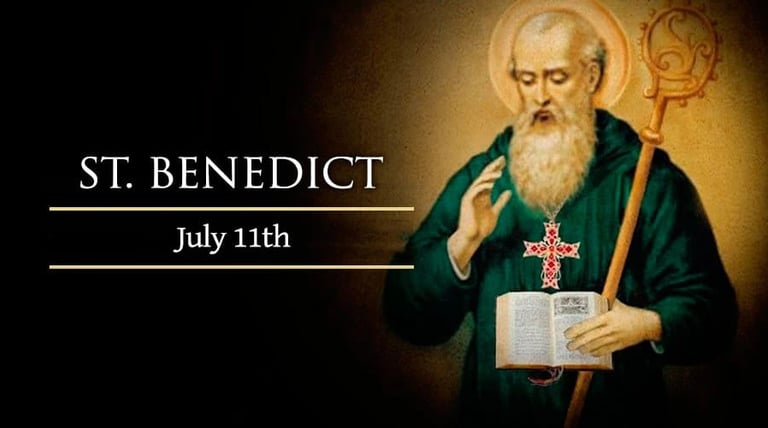Saint of the day July 11, 2025
St. Benedict
DAILY SAINT
Nirmala Josephine
7/11/20253 min read


Benedict was born in 480 into a distinguished family in Nursia, Italy. (His twin sister was a nun, St. Scholastica). He was educated in Rome, was repelled by the vices of the city, and in about 500, fled to Enfide, thirty miles away. He decided to live the life of a hermit and settled in the mountainous Subiaco. There, Benedict met a monk, Romanus, who gave him the monk's habit. By his advice, Benedict became a hermit and for three years, unknown to men, lived in a cave; Romanus served the saint and reportedly visited him frequently, and on fixed days brought him food.
Despite Benedict’s desire for solitude, his holiness and austerities became known, and he was asked to be the abbot of a community of monks at Vicovaro. He accepted, but when the monks resisted his strict rule and tried to poison him, he returned to Subiaco. Still, the shift from hermit to community life had begun for him, and soon he attracted great numbers of disciples. He organized them into twelve monasteries under individual priors he appointed, made manual work part of the program, and soon Subiaco became a center of spirituality and learning. He left suddenly, reportedly because of the efforts of a neighboring priest, Florentius, to undermine his work, and in about 525 settled at Monte Cassino. He had an idea of gathering various families of monks into one “Grand Monastery” to give them the benefit of unity, fraternity, and permanent worship in one house. Finally, in about 530, he began to build what was to become one of the most famous monasteries in the world and considered it to be the birthplace of Western monasticism—Monte Cassino, commanding three narrow valleys running toward the mountains north of Naples.
Soon, disciples again flocked to him as his reputation for holiness, wisdom, and miracles spread far and wide. He destroyed a pagan temple to Apollo, brought the people of the neighboring area back to Christianity. He organized the monks into a single monastic community and wrote his famous rule prescribing common sense, a life of moderate asceticism, prayer, study, and work, and stressed obedience, stability, zeal, and had the Divine Office as the center of monastic life; it was to affect spiritual and monastic life in the West for centuries to come. While ruling his monks (most of whom, including Benedict, were not ordained), he counseled rulers and Popes, ministered to the poor and destitute about him, and tried to repair the ravages of the Lombard Totila’s invasion. He died at Monte Cassino on March 21, 547. He was canonized in 1220.
Reflection
Throughout his life, St. Benedict was known for his wisdom, holiness, and miracles. He developed a reputation as a holy man and was sought out by people from all walks of life for guidance and counsel. He even gets visited by the Pope at one point, as well as by many noblemen and religious leaders of the time, all eager to hear his teaching.
One of the most striking characteristics of St. Benedict’s Rule is the balance that it strikes between the spiritual and the practical. Benedict’s understanding of monastic life was that it was not only about contemplating God, but also about living in the real world. In his Rule, he emphasised the value of manual labour, as well as the importance of hospitality and compassion for the poor and the sick.
In the Catholic Church, St. Benedict is remembered as a patron saint of Europe and of monks. His feast day is celebrated on July 11th, and his symbol is the raven, which is said to have saved his life when he was a young monk. He is also known as the “father of Western monasticism” due to the great influence of his rule.
The Rule of St. Benedict is still used by Benedictine communities today, and his teachings continue to be studied and reflected upon. His impact on the Western Church and society is undeniable and even today is acknowledged by many as one of the most important figures of Western monasticism.
